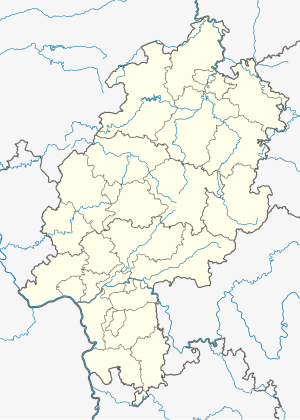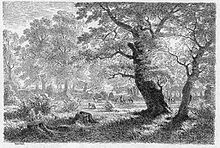Kranichstein Wildlife Park
| Kranichstein Wildlife Park | ||
|---|---|---|
| Species focus | Local game | |
| organization | ||
| Sponsorship | Hessen Forest | |
|
|
||
Coordinates: 49 ° 54 '39.1 " N , 8 ° 42' 55.3" E
The wildlife park Kranichstein is a middle of the woods at kranichstein in Südhessen situated wildlife park .
location
The wildlife park is located east of the Kranichstein hunting lodge between Dieburger Strasse and Kranichsteiner Strasse .
history
Landgrave Georg I acquired the Kranichstein estate from Johann von Rensdorff in 1572. The Kranichstein hunting lodge was built on the site of this former hermitage in the 16th century . During the reign of Landgrave George I, the castle was expanded into a representative Renaissance castle. In addition, a farm with a dairy farm, sheep farm, meadows, vineyards and fish ponds was built. As a result, he further developed it into a model good for the economic supply of the country.
This was followed by the reforestation of coniferous forests , the establishment of the pheasantry and the wildlife park. During this time the landscape was criss-crossed with aisles . The property became the center of courtly hunting culture and the temporary seat of government.
The hunting lodge and the estate were badly damaged in the Thirty Years' War . After the end of the war in 1648, the property was extensively renovated. At that time, Sophie Eleonore - the wife of George II - lived at Kranichstein Castle. Sophie Eleonore had the wildlife park enlarged and partially walled over. She redesigned part of it to a pleasure garden. The carefree between the Jagdschloss Kranichstein and the Steinbrücker pond goes back to her initiative.
In the 19th century the hunting lodge became the summer residence of the Grand Dukes.
The extensive wildlife park is part of the landscape characterized by mixed forest, meadows and streams and shows animals typical of the region in their natural habitat.
Wildlife park fence
From 1806 to 1945 the wildlife park was enclosed by an approximately 18-kilometer-long oak fence . The fence was supposed to keep the game in the park and protect the farmers' fields from game damage.
Towards the end of the Second World War , the Darmstadt population dismantled the fence and used it to heat their homes.
At the Speierhügel lane , immediately east of the Hengstriedwiese , there is a reconstruction of the fence approx. 5 meters long and approx. 2 meters high.
The wildlife park today
Today the fenced game park is home to the indigenous game species fallow deer , roe deer , red deer , badgers , hares , martens , red foxes , wild boars , capercaillie , pheasants , partridges , mallards , wild geese and woodcock .
Today, the forest meadows are among the most ecologically interesting meadows in the Kranichstein Wildlife Park. As alternately moist, nutrient-poor meadows, they are home to many rare and threatened animal and plant species. Almost a hundred of them are on the red list.
The wildlife park is also used today for environmental education. The wildlife park is open all year round. The wildlife park may not be entered at night. The forest meadows in the wildlife park may not be entered, even during the day. Daily tours are not offered. Admission is free. At the southern edge of the Rodwiese (also: Rottwiese ) there is a shelter with information boards .
Historical buildings
There are the following listed buildings in the wildlife park:
Forest meadows in the game reserve
There are the following forest meadows in the fenced game reserve:
- Stallion Riedwiese ( 49 ° 54 '13.3 " N , 8 ° 42' 44.3" O )
- Rodwiese ( 49 ° 54 '50.4 " N , 8 ° 42' 58.3" O )
- Hospital Wiese ( 49 ° 54 '12.8 " N , 8 ° 43' 53.4" O )
- Stadtförsterwiese ( 49 ° 54 ′ 25.9 ″ N , 8 ° 42 ′ 55.8 ″ E )
- Wannemacher's meadow ( 49 ° 54 ′ 58.6 ″ N , 8 ° 43 ′ 21.3 ″ E )
literature
- Günter Fries et al .: City of Darmstadt. ( Monument topography Federal Republic of Germany , cultural monuments in Hesse .) Vieweg Verlag, Braunschweig 1994, ISBN 3-528-06249-5 , p. 663ff.
- Roland Dotzert et al .: Stadtlexikon Darmstadt , Konrad Theiss Verlag GmbH, Stuttgart 2006, ISBN 3-8062-1930-3 and ISBN 978-3-8062-1930-2 , pp. 442 and 517f.
Individual evidence
- ↑ Information board on the reconstruction of the fence.
- ↑ Information boards at the shelter / Rottwiese.
- ↑ City Atlas Darmstadt and Surroundings, Official City Map Darmstadt, Surveying Office of the City of Science Darmstadt, Cartography Department, 2016, p. 20f.
- ↑ Hans Ramge et al .: Südhessisches Flurnamenbuch , Hessische Historische Kommission Darmstadt, 2002, ISBN 3-88443-045-9 .

